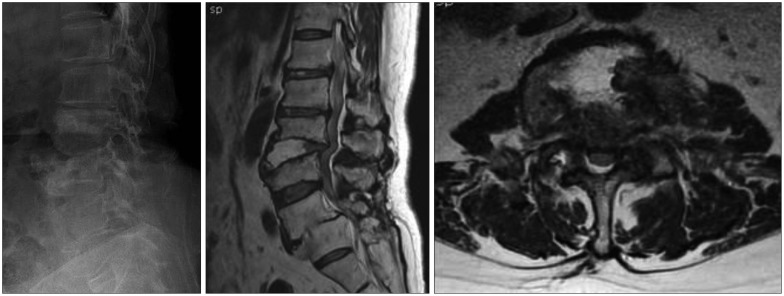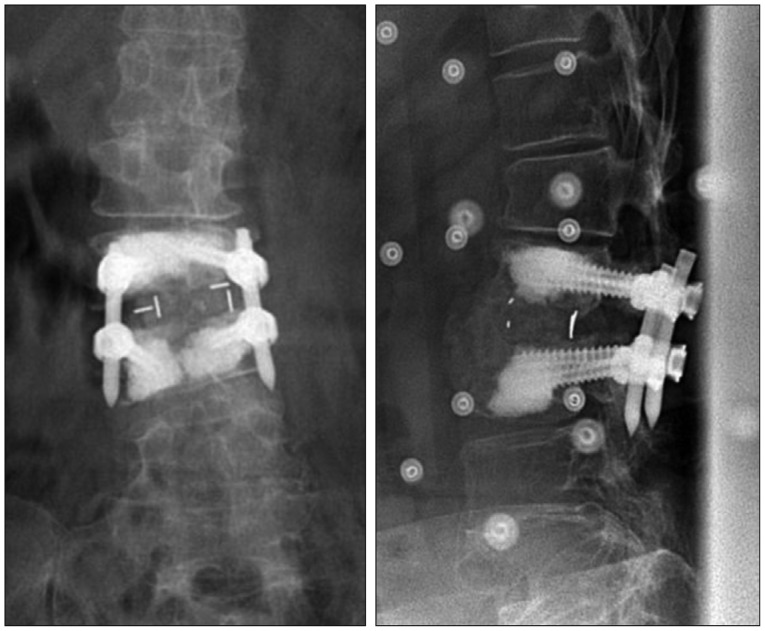J Korean Neurosurg Soc.
2015 Dec;58(6):560-562. 10.3340/jkns.2015.58.6.560.
Lying Down Instability Undetected on Standing Dynamic Radiographs
- Affiliations
-
- 1Department of Neurosurgery, Heori Sarang Hospital, Daejeon, Korea.
- 2Department of Neurosurgery, College of Medicine, Chosun University, Gwangju, Korea. chosunns@chosun.ac.kr
- 3Department of Rehabilitation, College of Medicine, Chosun University, Gwangju, Korea.
- KMID: 2151161
- DOI: http://doi.org/10.3340/jkns.2015.58.6.560
Abstract
- It is well known that spinal instability should be evaluated in the standing lateral position. Standing dynamic flexion and extension radiographs are usually used to assess spinal instability. Here, we report a patient who experienced distraction instability while in the supine position rather than the standard standing position. To our knowledge, this is the first report of lying-down instability undetected on standing dynamic flexion and extension radiographs. We discuss the pathophysiological mechanism of this uncommon but possible entity and provide a review of the literature.
Keyword
MeSH Terms
Figure
Reference
-
1. Choi KC, Kim JS, Jung B, Lee SH. Dynamic lumbar spinal stenosis : the usefulness of axial loaded MRI in preoperative evaluation. J Korean Neurosurg Soc. 2009; 46:265–268. PMID: 19844630.
Article2. D'Andrea G, Ferrante L, Dinia L, Caroli E, Orlando ER. "Supine-prone" dynamic X-ray examination : new method to evaluate low-grade lumbar spondylolisthesis. J Spinal Disord Tech. 2005; 18:80–83. PMID: 15687857.3. Iguchi T, Kanemura A, Kasahara K, Sato K, Kurihara A, Yoshiya S, et al. Lumbar instability and clinical symptoms : which is the more critical factor for symptoms : sagittal translation or segment angulation? J Spinal Disord Tech. 2004; 17:284–290. PMID: 15280756.4. Kanayama M, Hashimoto T, Shigenobu K, Oha F, Ishida T, Yamane S. Intraoperative biomechanical assessment of lumbar spinal instability : validation of radiographic parameters indicating anterior column support in lumbar spinal fusion. Spine (Phila Pa 1976). 2003; 28:2368–2372. PMID: 14560085.
Article5. Kanayama M, Tadano S, Kaneda K, Ukai T, Abumi K, Ito M. A cineradiographic study on the lumbar disc deformation during flexion and extension of the trunk. Clin Biomech (Bristol, Avon). 1995; 10:193–199.
Article6. Penning L, Blickman JR. Instability in lumbar spondylolisthesis : a radiologic study of several concepts. AJR Am J Roentgenol. 1980; 134:293–301. PMID: 6766236.
Article7. Schafer RC. Body alignment, posture, and gait. In : Schafer RC, editor. Clinical Biomechanics : Musculoskeletal Actions and Reactions. ed 2. Baltimore: Wiliams & Wilkins;1987. p. 789.8. Schneider G, Pearcy MJ, Bogduk N. Abnormal motion in spondylolytic spondylolisthesis. Spine (Phila Pa 1976). 2005; 30:1159–1164. PMID: 15897830.
Article
- Full Text Links
- Actions
-
Cited
- CITED
-
- Close
- Share
- Similar articles
-
- Statistical Study of the Lumosacral Angles in Lumbago Patients
- Delayed or Missed Diagnosis of Cervical Instability after Traumatic Injury: Usefulness of Dynamic Flexion and Extension Radiographs
- Clinical Implication of Mid-Range Dynamic Instability in Lumbar Degenerative Spondylolisthesis
- Utility of Seated Lateral Radiographs in the Diagnosis and Classification of Lumbar Degenerative Spondylolisthesis
- Efficacy of Dynamic Radiographs in Routine Evaluations for Degenerative Cervical Spine Disease




